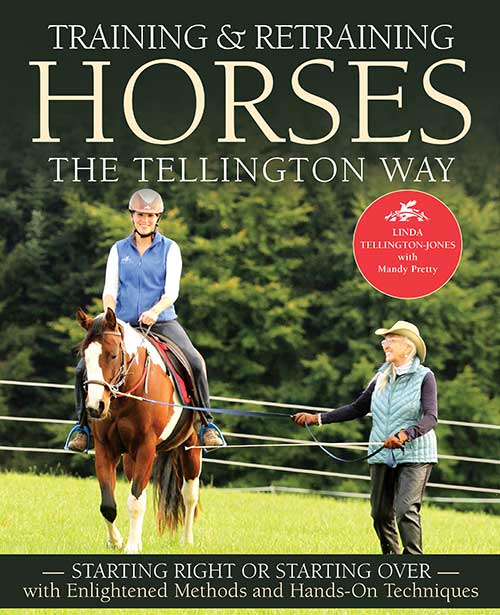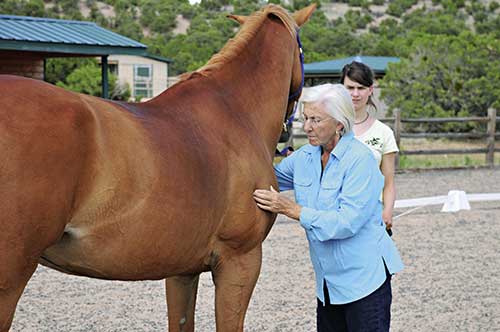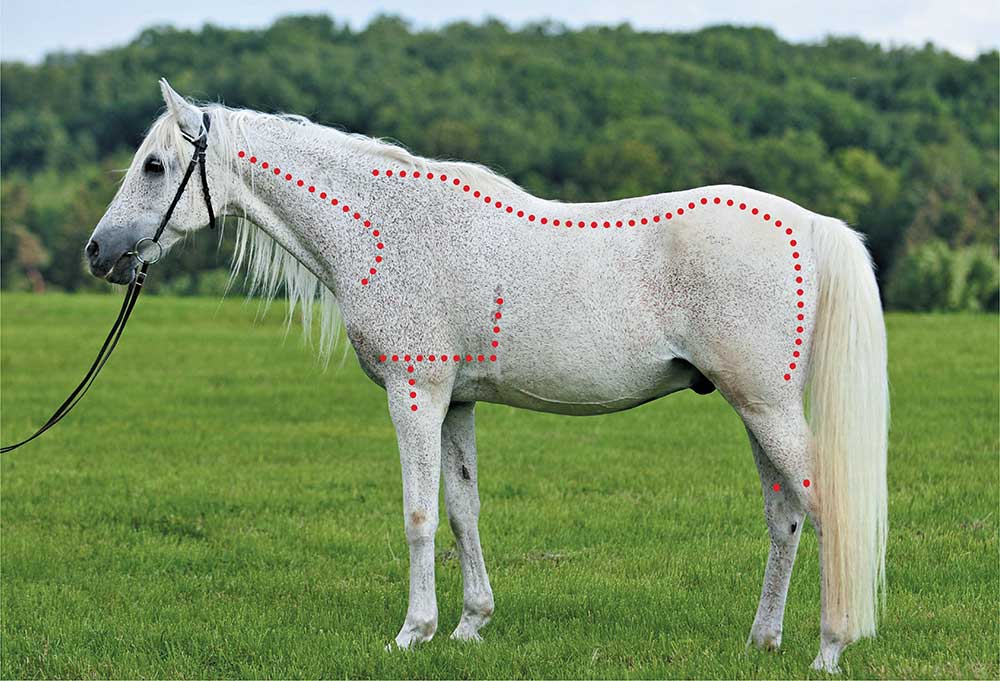
by Linda Tellington-Jones
Before starting any exercise, take the time to connect and listen to your horse with your hands. You can easily do this by mindfully running your hands all over your horse’s body. This simple Body Exploration exercise will provide you with valuable information regarding your horse’s state of body and mind as well as his level of trust in you as a handler.
A horse that is very comfortable being touched all over his body will be better prepared for any experience under saddle than one that is defensive, ticklish, or tense.
Having a horse that is truly happy and comfortable about being touched is incredibly important. Not only does this signify relaxation and physical well-being, it also tells you a lot about how much he trusts you. This is also very significant for horses that are already trained but may be having specific issues under saddle.
Going back to the basics and helping your horse become comfortable about being touched everywhere will often help seemingly unrelated training issues.
For instance, if your horse has a tight, clamped tail, you will often find that this same horse may be nervous about noises or movement behind him.
How to Use It
Begin by checking the horse’s body with your flat hand. It is helpful to have someone holding your horse, or you can work freely in a stall-sized area, rather than having him tied up, so you can observe his reactions. Stroke the horse on the shoulder before beginning your Body Exploration to prepare him so he does not respond just because he was surprised.
For some very sensitive horses the flat of the hand may be too much. If this seems to be the case, try using the back of your hand.
Starting at the poll, right behind the ears, let your hands slide over the strong neck muscle, paying close attention along the way. Your hands are feeling for slight irregularities: swellings, change in temperature, quality of the tissue, hard muscles, twitching, knots, change in the hair, scars, or areas where the horse is uncomfortable being touched.
It is best to start with a light pressure, which you can adjust if the sensitivity or reaction of the horse requires you to do so. Sometimes horses are surprised by the touch of the fingertips; therefore, it is important to check if it was a startle reflex, or the horse reacting because he is tight.
A healthy horse that is not tense will usually show a light response to a light pressure. When going over the poll and neck this horse will lower his neck, while a horse that is tight will raise his head and possibly show pain or fear.


Horses express themselves with their body language by holding their breath, pinning their ears, raising their heads, chewing on things, pawing, or moving away from the touch. Pay close attention to small signals. Horses are very different from one another and some breeds are more expressive than others.
For example, an Arabian or Thoroughbred will respond quite differently from a Quarter Horse or draft horse whose responses may be barely noticeable. This is where it is incredibly important to move slowly and watch for subtle reactions. If you have a helper, ask her to tell you anytime she notices a shift in the horse’s posture or body language.
A more stoic horse may demonstrate his concern or anxiety with rapid respiration or a tightening of the eye or nostril. Take the time to pause and then go back to the place where you found these subtle responses to see if it was a fluke or if it happens every time you touch the area. Becoming an observant detective to these subtle cues will make you a better “horse listener” and improve the way you understand your horse.
As you move on to exploring the horse’s back remember to check about 4 inches to each side of the spine along the longissimus dorsi muscle. It is also very useful to check the muscles along the croup and down the hindquarters along the hamstrings. Horses that react strongly here are often nervous of sounds or movement behind them or when going through narrow spaces.
Recognize and Respond
Learning to recognize the signals that your horse is providing you is so important. Respond to these signals appropriately by noting the sensitive areas and coming back to them later with a more gentle touch.
When a horse “does not like something” simply change how you’re doing it by using a different speed, pressure, part of the hand, or add a sheepskin mitt or soft cloth to diffuse the contact.
Explore the horse’s entire body with your flat hand. You may want to get in the habit of doing this whenever you groom your horse. This “mindful grooming” will give you information about how your horse and his body are feeling each day and will allow you to reduce any developing tension patterns before they turn into unwanted behaviors or increased pain.
This excerpt from Training & Retraining Horses the Tellington Way by Linda Tellington-Jones is reprinted with permission from Trafalgar Square Books (www.horseandriderbooks.com).
There are more excellent articles in our section on Health & Education.

































